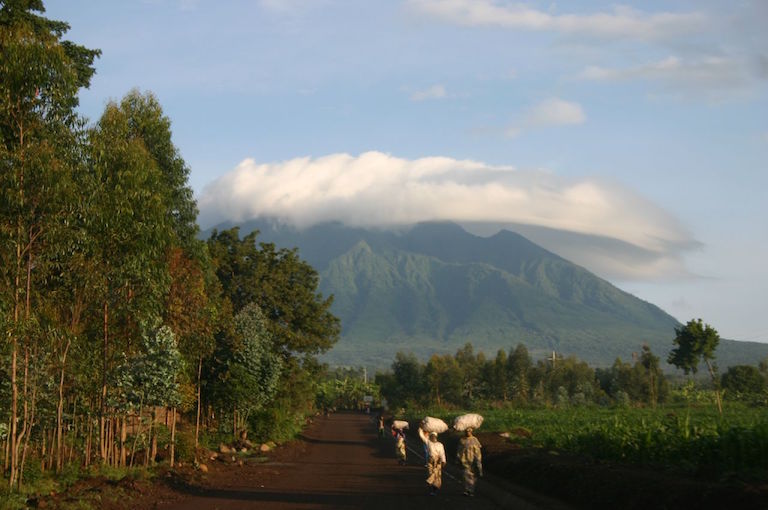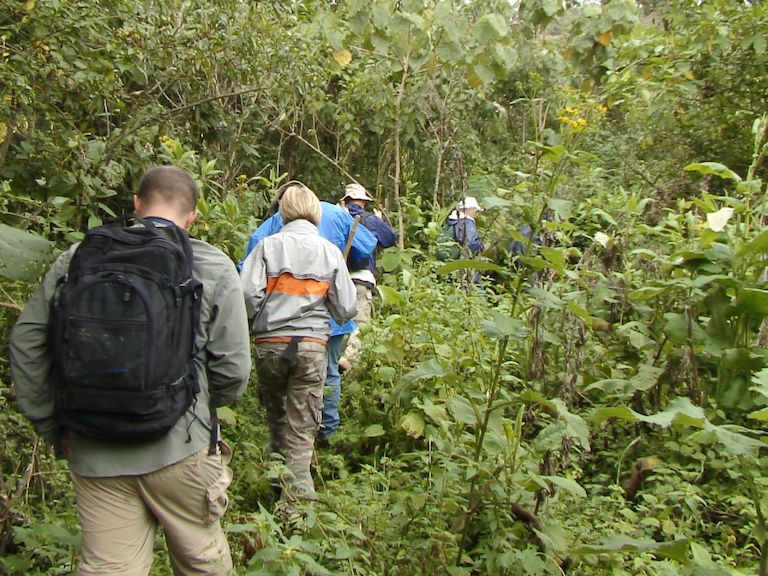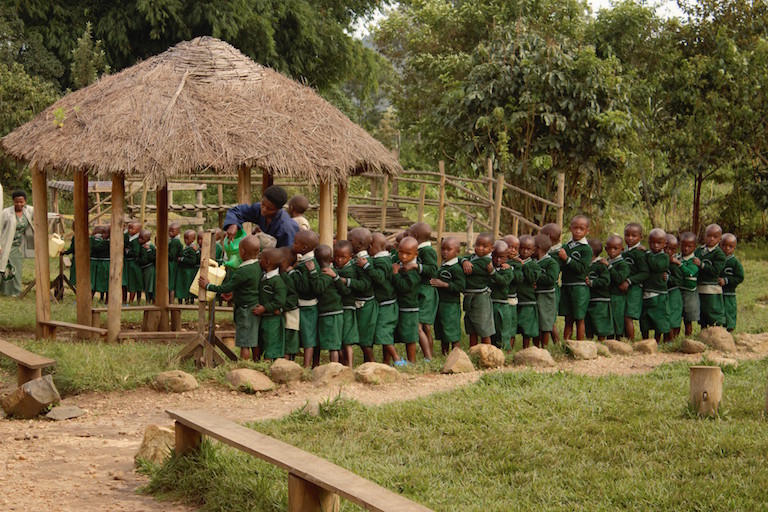- While studying Rwanda’s critically endangered mountain gorillas in the 1970s, newlywed graduate students Amy Vedder and Bill Weber learned that the government was considering converting gorilla habitat into a cattle ranch.
- At the time, conventional wisdom held that the mountain gorillas would inevitably go extinct. But Vedder and Weber believed the species could be saved, and proposed a then-revolutionary ecotourism scheme to the Rwandan government.
- Forty years later, that scheme has proved its worth. Mountain gorilla populations have rebounded, and tourism generates hundreds of millions of dollars per year. Vedder and Weber now work to inspire the next generation of conservationists both in Rwanda and abroad.
- In a series of interviews with Mongabay, Vedder and Weber reflect on a life in conservation.
December 1978
A year into an 18-month research project on the critically endangered mountain gorilla in Rwanda’s Volcanoes National Park, Amy Vedder and Bill Weber, newlywed graduate students from the University of Wisconsin, stumbled upon a plan that would destroy the very populations they hoped to save.
By the late 1970s, poaching and habitat loss had reduced the population of mountain gorillas (Gorilla beringei beringei) to just 260 individuals, and conventional wisdom held that the great ape was destined for extinction. But Vedder and Weber, who were working out of Dian Fossey’s world-renowned Karisoke Research Center, believed they had enough data to question the inevitability of the species’ demise.
Instead, based on what was at the time a groundbreaking interdisciplinary approach, they believed that if local people were given the right tools and incentives, this steep decline in population could be reversed.

Then one day an acquaintance casually lamented, “It’s so sad what’s happening in the park.”
“What’s going on in the park?” Weber asked.
They soon learned that the European Development Fund (EDF) had advised the Rwandan government to raze one-third of the 160-square-kilometer (62-square-mile) park for a cattle project, estimated to generate $70,000 a year. Compared with the $7,000 in annual entry fees raised by the park, swapping “useless” forest for income-producing cattle in one of the world’s most densely populated and impoverished nations appeared justifiable.
Not to Vedder and Weber. They canceled their planned return to the U.S., deciding to stay in Rwanda and find a way to transform their research into a project that would earn more revenue than milk and beef.
“It had been written by a number of knowledgeable people, ‘they’re going extinct. It’s too small a population. You can’t rescue them,’” Vedder says. But she believed otherwise.
“Amy’s research showed that the habitat was viable. The demographics revealed that the gorillas were reproducing. And my surveys and discussions with local people, academics and national officials indicated they were not anti-gorilla,” Weber tells Mongabay in an interview at Yale’s Graduate School of Forestry and Environmental Sciences in New Haven, Connecticut, where they now teach.
The EDF-backed plan threatened to scuttle any hopes of a recovery. Ten years earlier, the development agency had already convinced the government to convert 105 square kilometers (40 square miles) of the park, considered one of the most biodiverse on the planet, to farm pyrethrum, a plant from which an insecticide compound is extracted. Human habitation and agriculture were driving the apes further up the mountain, depleting the vegetation they depended upon for food, and further shrinking their habitat. Vedder and Weber were certain that the gorillas could not survive another reckless plunder of their precious resources.
“It was time for action,” Weber says.

Amy Vedder and Bill Weber grew up in upstate New York and met at Swarthmore College, outside Philadelphia. Vedder, who excelled in math and science, dreamed of working in a realm where there would be puzzles to solve and something new to discover each day. Biology, she concluded, offered all those things. Weber was majoring in psychology with a minor in English.
“He liked weighing big ideas,” Vedder, 67, says. “His friends and he were real jokesters and jocks. It was a nice counterpoint for me, and provided a respite to studying hard.”
“She was already thinking professionally about something to do with wildlife and animal behavior,” says Weber, 68, who was already imagining spending a lifetime together. “I thought environmental law could be an interesting complement.” They married the summer after graduation. When they didn’t get accepted to nearby graduate schools, they decided to serve as Peace Corps volunteer teachers in Zaire (now the Democratic Republic of Congo).
Working within an African institution, they became proficient in French and Swahili and immersed themselves in local life. During their time off, they traveled to the great savanna parklands of Kenya and Tanzania: Serengeti, Amboseli, Tarangire and Ngorongoro. That cemented their desire to pursue conservation together.

A visit to Kahuzi-Biega National Park in the DRC, home to one of the last groups of eastern lowland gorillas (Gorilla beringei graueri) convinced them to focus their work on great apes. “That was the start of the gorilla itch,” Vedder says. “We saw them there twice with the warden. I asked him if there was something we could do to help the park.” They were shocked when Adrien de Schryver, the chief warden, invited them to assist him conduct a census and help with a gorilla tourism initiative.
When their teaching duty ended, Vedder and Weber returned to the U.S. to secure affiliation with the University of Wisconsin and make plans to return to the DRC to work with the gorillas. Vedder switched her field of study from animal behavior to field biology. “I realized if we wanted to make a difference for endangered species, we needed to know basic ecological requirements. What foods do they eat, where were they found, and was there enough,” she says.
Moved by the human poverty he observed on the fringes of the parks they had visited, Weber wanted to investigate how conservation and tourism might benefit local people. Wisconsin offered a new interdisciplinary Ph.D. in applied conservation science that fit his interests in social science and wildlife.
When a fellow graduate student connected them with a primatologist who initiated an invitation from Fossey, they headed for Rwanda.
After months observing gorilla families and conducting ecological analysis at Volcanoes National Park, Vedder concluded that the gorillas carefully selected the vegetation they ate to balance their vitamins and minerals. She discovered more than 100 additional plants and shrubs that they fed on that were not formerly known. “There were resources there. They didn’t have to go extinct,” she says.

Weber cultivated relationships with leaders in the national and local governments and the bureaus of parks and forestry. He got to know the local community and school officials. “It was about learning who the decision-makers were and having influence on them to help set a legal framework,” he says.
Savanna park “safari” tourism was the model in the 1970s, which meant going to see lions, elephants and zebras from the comfort of a Land Rover, then heading back to the lodge for a gin and tonic. Ecotourism was not yet a concept. Weber and Vedder came up with an approach that was radical at the time but seems visionary now. They envisioned people setting out on foot, following elephant and buffalo trails, to eventually find and observe gorillas deep in the forest. Weber trained knowledgeable, local guides to lead small groups of no more than eight visitors for an hour spent with a primate family.
“There were several European tourism advisers in Rwanda that said ‘People don’t want to get wet, muddy and cold. You’re just graduate students. This can’t work,’” Vedder says. “When the local government said, ‘Try it,’ we had the opportunity to find out.”
They proposed a three-part approach — education, tourism and anti-poaching — drawing on lessons learned from their biology and social science studies. Their plan, they argued, could bring in far more revenue, on a sustainable basis, than the EDF’s cattle project, and without the huge capital investment that ranching required.
With the government’s green light, they co-founded the Mountain Gorilla Project in the summer of 1979. Known today as the International Gorilla Conservation Program, the project has evolved into a conservation consortium supported by Flora & Fauna International and the WWF. (The African Wildlife Foundation, one of the original funders, dropped out of the coalition in 2017.)
Their proposal developed into a three-part project. The AWF oversaw the anti-poaching work, while Vedder and Weber led the tourism and education components, hiring and training Rwandans to eventually take over.
Introducing tourism and working in a partnership with Rwandans meant a break with Fossey, who argued that daily human visitation would upset the primates and could hasten what she felt was their inevitable demise. The brutal killing a year earlier of Digit, a gorilla she cherished, had soured her view on the future for gorillas. She expressed skepticism that Rwandans were capable of managing gorilla conservation efforts.

By the mid-1980s, each component of the project was demonstrating visible progress, according to Vedder, with Rwandans working on the ground and at the helm. The preservation of gorilla habitat proved to be as profitable as clearing land for cattle grazing.
Vedder and Weber shuttled back and forth between field work in Rwanda and completing their doctorates. They built on their experience in the mountain gorilla project, taking on larger projects. Weber helped develop a watershed management program for the human population surrounding Volcanoes National Park. Vedder led projects in other comparable mountain ecosystems, such as Rwanda’s Nyungwe forest, and in Uganda, Burundi and eastern DRC.
When Weber was appointed director of the Wildlife Conservation Society’s Africa Program in 1988, the couple moved to New York, visiting Rwanda annually. Two years later, the Rwandan civil war erupted, then escalated into the cataclysmic 1994 genocide of more than 800,000 people in 100 days. A census conducted after recovery revealed a continued uptick in the gorilla population. “Both sides had agreed not to fight within the park because they had recognized by then the tremendous economic value of the park and tourism,” said Vedder.
“Amy and Bill are pragmatic conservationists who understood the socio, political and economic context of Rwanda and developed a conservation model that fits our unique circumstances and integrates local need and conservation objectives,” Michel Masozera, 50, deputy leader of wildlife practice for WWF International and an award-winning conservationist, wrote in an email.
Vedder and Weber’s vision, dedication and pioneering work for wild lands and wildlife in Rwanda continues to reap rewards. In November, the Swiss-based International Union for Conservation of Nature (IUCN) announced that the iconic “silverback” apes roaming the Virunga Mountains which straddle Rwanda, the DRC and Uganda, as well as a small population that inhabits Uganda’s Bwindi Impenetrable National Park, have seen their conservation status improve from “critically endangered” to “endangered.”
You could say Vedder envisioned this after the census she conducted in 1986 revealed 293 gorillas, the first increase in a decade. It prompted her to predict that by 2010, the Virunga population could theoretically return to the 450 individuals recorded in a 1960 census. The population, in fact, rose to 480 and continued to grow. Today, the total mountain gorilla population exceeds 1,000 individuals, with 604 in the Virungas.

December 2018
Mountain gorillas have become a national treasure in Rwanda. A silverback appears on the 5,000 -franc bill. There’s an annual baby gorilla-naming ceremony, Kwita Izina, which celebrates each year’s new batch of gorilla infants. Gorilla images adorn an array of Rwandan brands, from hotels to coffee.
Each day, up to 96 visitors, in groups of eight at the most, spend 60 strictly monitored minutes with one of the country’s 12 habituated primate families at Volcanoes National Park. For this, they pay up to $1,500 each. Tourism in Rwanda today generates more than $400 million annually, more than coffee, tea and minerals combined, according to the Rwanda Development Board. And the most popular tourist activity is tracking mountain gorillas.
Plans for a $200 million expansion of Volcanoes National Park and a project to reforest the habitat that was parceled for pyrethrum were announced earlier this year. “It will be a huge challenge, both ecologically and socially,” Weber says. “It’s going to engender some controversy on the part of people who support conservation but also want to make sure that local people are dealt with properly.”
“Conservation never ends,” Vedder says. “The issues evolve and change. Fresh challenges arise. There’s always a new set of ideas to attend to.”

A few years ago, Vedder tells me, she and Weber began thinking about how their decades-long life work might be useful to young people beginning careers in conservation. They felt compelled to impress upon students that it’s not a straight line from here to there. “You wander, wobble and fall. Then pick yourself up again. Conservation is a long-term process,” she says.
In 2013, Yale invited the couple to lecture about their experience as practitioners of conservation for a semester. The students responded positively, and Vedder and Weber found themselves equally enthusiastic about the exchange. They returned the following year, and that evolved into two popular conservation courses they teach every spring.
Each May, Vedder and Weber take turns accompanying five students, selected with academic and cultural diversity in mind, for a monthlong study tour through Rwanda. The tour is structured to expose the students to a range of perspectives. They meet with NGOs, government officials and community members. They visit local cooperatives and museums. They track gorillas at Volcanoes and visit two other Rwandan national parks: Nyungwe, a mid-altitude montane forest, and Akagera, a savanna wetland, near the border with Tanzania.

Students gain perspective about the challenges that presented themselves to Vedder and Weber 40 years ago, and see how their solutions have evolved. “Reading the theories of this and the principles of that is great in a perfect world,” Vedder says. It’s another thing, however, to “live in a village for three days and talk to people about what it’s like living next to a park.”
Bethany Linton, 27, a second-year master’s student in environmental science, says she was most impressed by the candidness of the conversations and the nuanced viewpoints and perspectives from leaders in management, government and residents in the area, many of whom had had years of relationships and trust with Vedder and Weber. “Conversations about human rights, community income generators and revenue-sharing programs that the park management and government have promised and organized were the most compelling for me personally,” she says. “I think it’s so important to work through genuine relationships even when you’re doing global work, and that’s exemplified by Amy and Bill.”
For Andy Lee, 26, a first-year master’s student, it was disagreements about the land expansion that made the biggest impression. “We talked to NGOs, a park head, and government officials in Kigali,” he says, adding that heated debates around political and human-wildlife conflicts characterized most discussions. “We tried to imagine the possible outcomes of the expansion, drawing experience from our own countries and other part of Africa,” he says.

How do you make conservation happen when the gorilla population moves around the boundaries of three countries was a question that fascinated Martin Becker, 33, who received his master’s degree in environmental management from Yale in 2017 and went on to co-found Tepual Conservacion, a consultancy for privately owned protected areas in Chile. “The coordination of a three-nation conservation program, each with different priorities and levels of political stability was one of the discussions that impressed me the most,” he says.
For Vedder and Weber, the ability to spend their lives working together on important, global projects that have improved the world has been a gift. “It’s given me an optimistic view on life. Here’s something we worked really hard at that has shown tangible results. That sense that one can make a difference permeates a lot of my life,” Vedder says.
Weber concurs: “It’s hard to be completely optimistic about conservation these days but it shows that if you make an effort you can make a difference. Cooperation is a powerful tool. We weren’t the people who stayed and did all this. We did help get it started. A lot of people have worked together to make the mountain gorilla story what it is today.”

FEEDBACK: Use this form to send a message to the author of this post. If you want to post a public comment, you can do that at the bottom of the page.
Editor’s note: this story was updated Jan. 1 to correct the spelling of Bethany Linton’s last name.














